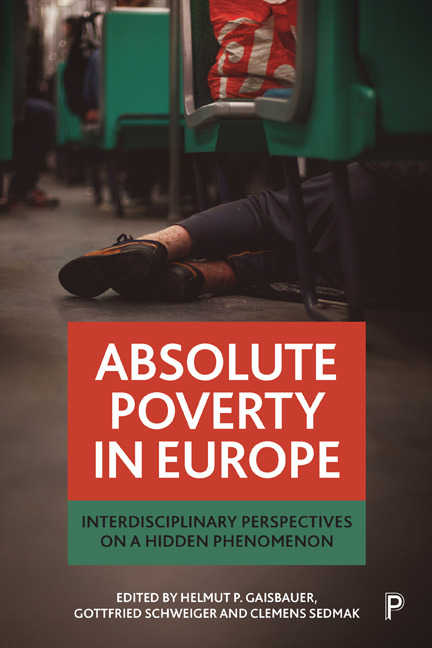52 results
P.025 Efficacy and safety results of the avalglucosidase alfa phase 3 COMET trial in participants with late-onset Pompe disease (LOPD)
-
- Journal:
- Canadian Journal of Neurological Sciences / Volume 48 / Issue s3 / November 2021
- Published online by Cambridge University Press:
- 05 January 2022, p. S27
-
- Article
-
- You have access
- Export citation
Part Four - Ethical perspectives on absolute poverty in Europe
-
- Book:
- Absolute Poverty in Europe
- Published by:
- Bristol University Press
- Published online:
- 27 April 2022
- Print publication:
- 03 April 2019, pp 361-362
-
- Chapter
- Export citation
List of figures and tables
-
- Book:
- Absolute Poverty in Europe
- Published by:
- Bristol University Press
- Published online:
- 27 April 2022
- Print publication:
- 03 April 2019, pp v-vii
-
- Chapter
- Export citation
Part One - Conceptual and methodological challenges
-
- Book:
- Absolute Poverty in Europe
- Published by:
- Bristol University Press
- Published online:
- 27 April 2022
- Print publication:
- 03 April 2019, pp 15-16
-
- Chapter
- Export citation

Absolute Poverty in Europe
- Interdisciplinary Perspectives on a Hidden Phenomenon
-
- Published by:
- Bristol University Press
- Published online:
- 27 April 2022
- Print publication:
- 03 April 2019
Contents
-
- Book:
- Absolute Poverty in Europe
- Published by:
- Bristol University Press
- Published online:
- 27 April 2022
- Print publication:
- 03 April 2019, pp iii-iv
-
- Chapter
- Export citation
Notes on contributors
-
- Book:
- Absolute Poverty in Europe
- Published by:
- Bristol University Press
- Published online:
- 27 April 2022
- Print publication:
- 03 April 2019, pp viii-x
-
- Chapter
- Export citation
Conclusion responding to the dark reality of absolute poverty in European welfare states
-
-
- Book:
- Absolute Poverty in Europe
- Published by:
- Bristol University Press
- Published online:
- 27 April 2022
- Print publication:
- 03 April 2019, pp 397-410
-
- Chapter
- Export citation
1 - Absolute poverty in Europe: introduction
-
-
- Book:
- Absolute Poverty in Europe
- Published by:
- Bristol University Press
- Published online:
- 27 April 2022
- Print publication:
- 03 April 2019, pp 1-14
-
- Chapter
- Export citation
Index
-
- Book:
- Absolute Poverty in Europe
- Published by:
- Bristol University Press
- Published online:
- 27 April 2022
- Print publication:
- 03 April 2019, pp 411-430
-
- Chapter
- Export citation
Part Two - Key issues for the absolute poor
-
- Book:
- Absolute Poverty in Europe
- Published by:
- Bristol University Press
- Published online:
- 27 April 2022
- Print publication:
- 03 April 2019, pp 119-120
-
- Chapter
- Export citation
Part Three - Policy responses to absolute poverty in Europe
-
- Book:
- Absolute Poverty in Europe
- Published by:
- Bristol University Press
- Published online:
- 27 April 2022
- Print publication:
- 03 April 2019, pp 247-248
-
- Chapter
- Export citation
Frontmatter
-
- Book:
- Absolute Poverty in Europe
- Published by:
- Bristol University Press
- Published online:
- 27 April 2022
- Print publication:
- 03 April 2019, pp i-ii
-
- Chapter
- Export citation
A Decision on Inheritance Tax by the German Constitutional Court: A Brief Comment
-
- Journal:
- German Law Journal / Volume 16 / Issue 5 / October 2015
- Published online by Cambridge University Press:
- 06 March 2019, pp. 1227-1234
-
- Article
-
- You have access
- Export citation
The effect of transportation and lairage on faecal shedding and carcass contamination with Escherichia coli O157 and O26 in very young calves in New Zealand
-
- Journal:
- Epidemiology & Infection / Volume 146 / Issue 9 / July 2018
- Published online by Cambridge University Press:
- 23 May 2018, pp. 1089-1100
-
- Article
-
- You have access
- HTML
- Export citation
Insights into the deformation behavior of the CrMnFeCoNi high-entropy alloy revealed by elevated temperature nanoindentation
-
- Journal:
- Journal of Materials Research / Volume 32 / Issue 14 / 28 July 2017
- Published online by Cambridge University Press:
- 27 July 2017, pp. 2658-2667
- Print publication:
- 28 July 2017
-
- Article
- Export citation
Secondary nucleation of monomers on fibril surface dominates α-synuclein aggregation and provides autocatalytic amyloid amplification
-
- Journal:
- Quarterly Reviews of Biophysics / Volume 50 / 2017
- Published online by Cambridge University Press:
- 20 March 2017, e6
-
- Article
-
- You have access
- Open access
- HTML
- Export citation
Is nutrient intake associated with physical activity levels in healthy young adults?
-
- Journal:
- Public Health Nutrition / Volume 19 / Issue 11 / August 2016
- Published online by Cambridge University Press:
- 22 February 2016, pp. 1983-1989
-
- Article
-
- You have access
- HTML
- Export citation
Probing the magnetic field structure in the filamentary cloud IC5146
- Part of
-
- Journal:
- Proceedings of the International Astronomical Union / Volume 11 / Issue S315 / August 2015
- Published online by Cambridge University Press:
- 12 September 2016, E80
- Print publication:
- August 2015
-
- Article
-
- You have access
- Export citation
Contributors
-
-
- Book:
- Maternal Critical Care
- Published online:
- 05 July 2013
- Print publication:
- 04 July 2013, pp ix-xiv
-
- Chapter
- Export citation

